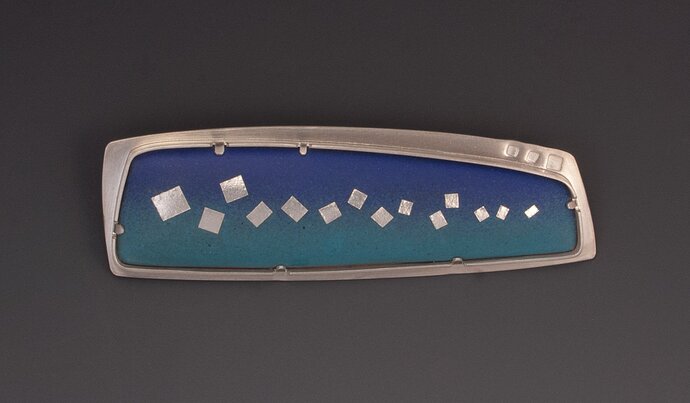Materials: vitreous enamel, copper, sterling silver, fine silver, stainless steel
Dimensions: 2 3/4" x 7/8" x 1/4"
Enameled copper, set in sterling silver, with a stainless steel pin stem. Inspired by they sky at dusk from a plane, gradient blues create a rich background for the silver foil squares.
Photo credit: Wendy Walsh
Wendy Walsh
Glencoe, MO. USA
Working with metals I find it necessary to constantly strike a balance between the form I have in mind and what the metal lends itself to becoming. A plain strip of sheet metal can become a beautiful form with just a simple bend or twist. I usually begin with a simple form that I find intriguing and then build on it, drawing from animal and plant forms, sometimes incorporating a sense of motion. When I’m having trouble with the progression of my work, it’s usually because I’m fighting the material rather than taking advantage of its properties. My satisfaction comes from understanding the material and finding what it can do for me.
The use of vitreous enamels in this work allows me to achieve color that I can manipulate with various tools and multiple firings. It produces a rich surface that is only somewhat predictable, bringing surprise and complexity to the metal.
The exhibition explores metal works whose primary theme is color embraced as their primary visual focus, whether that be using colored materials, exploring creating colored surfaces, or encasing the object in color.
As the world’s largest jewelry related internet site, Ganoksin strives to develop exhibitions showcasing work from around the world. This exhibition was open to all metalsmiths, professional and amateur, advanced and beginner.
In total 303 artists contributed 814 show pieces for the permanent online exhibition.
The exhibition was curated by Beth Wicker, President of the North Carolina Society of Goldsmiths in the United States, and Adjunct Instructor at Northeastern Technical College in South Carolina. Director of the exhibition is Hanuman Aspler, founder of The Ganoksin Project, the world’s largest internet jewelry site.
Hue is one of the primary properties of color, it refers to the place the color occupies on the visual spectrum. Humans have used hues throughout time, to create cave paintings, to decorate themselves, their clothing and their housing.
Different hues have taken on different meanings throughout time. Gold traditionally has been a color of purity - the metal gold is relatively unchangeable, and the hue of gold has come to stand for gods and goddesses, for royalty, for durability and for purity. Red has often meant love, or passion. Hues often reflect the meaning of the seasons, with pastels referring to spring and the burst of new life after the pale hues of winter. Summer is reflected in vibrant, deep hues, followed by the browning of hues in the fall as plants go to seed and die, and the land turns fallow.
The worth of a hue has often been tied to what is necessary to make the pigment that creates the hue, and the expensive involved in the process. Often created from crushed stones that had to be mined and carried by caravan over thousands of miles, or from fermented roots of plants only grown in certain areas, or the carapaces of rare insects - the creation of hue in a way that could be used by man was an involved and generally expensive process.
In today’s world metalsmiths have access to perhaps the widest range of materials and hues in the history of man - and in some of the most affordable ways ever.
This exhibition celebrates hue - color - as an integral, inherent element of the work. We talk of the “richness” of color, and examples of this abound here. One expects hues from the colors of gemstones used in metalsmithing, but we also have hues from some less expected places. Glass enamels are an ancient way of adding color, as are a variety of patinas. Today’s artists also use synthetic man-made materials to add color in ways that didn’t exist a century ago.
We invite you to enjoy this celebration of hue, and the ways hues and their use have changed over time.
